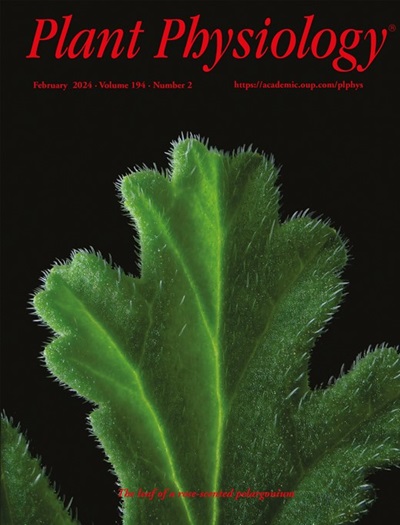必要但不可缺少:肉桂酸4-羟化酶在水稻细胞壁木质化中的作用
IF 6.5
1区 生物学
Q1 PLANT SCIENCES
引用次数: 0
摘要
全面了解草中复杂的木质素生物合成过程有助于提高我们利用草生物量的能力。肉桂酸4-羟化酶(C4H)与苯丙氨酸解氨酶(PAL)共同启动苯丙氨酸进入肉桂酸/单酚途径,导致多种苯丙氨酸的产生,包括木质素单体。尽管对禾本科植物C4H的研究非常广泛,但禾本科植物C4H的遗传研究仍然相当有限。值得注意的是,C4H在苯丙氨酸/酪氨酸解氨酶(PTAL)存在时的作用尚不清楚,PTAL是一种草特有的解氨酶,可以通过将酪氨酸招募到肉桂酸/单脂醇途径中来绕过保守的PAL-C4H途径。为了解决这一空白,研究人员产生了一组基因组编辑的水稻(Oryza sativa)突变体,其中包含水稻C4H基因的敲除突变,并对其进行了生长表型和细胞壁化学型分析,同时进行了同位素喂养和化学抑制剂试验,以测试PAL-C4H和PTAL途径的贡献。c4h敲除水稻突变体的表型和化学型特征表明,ⅰ类(OsC4H1)和ⅱ类(OsC4H2a和OsC4H2b) C4Hs协同促进水稻木质素的生物合成。然而,C4H缺乏对水稻植株发育和木质素形成的影响似乎不像在苦穗子中报道的那样显著。13c标记的苯丙氨酸和酪氨酸饲喂实验表明,即使苯丙氨酸来源的PAL-C4H途径完全阻断,c4h敲除水稻仍然可以通过酪氨酸来源的PTAL途径产生大量木质素并维持良好的细胞壁。综上所述,本研究证明了C4H在草细胞壁木质化过程中不可或缺的作用。本文章由计算机程序翻译,如有差异,请以英文原文为准。
Essential Yet Dispensable: The Role of CINNAMATE 4-HYDROXYLASE in Rice Cell Wall Lignification
A comprehensive understanding of the intricate lignin biosynthesis in grasses could contribute to enhancing our ability to utilize grass biomass. CINNAMATE 4-HYDROXYLASE (C4H), in conjunction with PHENYLALANINE AMMONIA-LYASE (PAL), initiates the entry of phenylalanine into the cinnamate/monolignol pathway, leading to the production of diverse phenylpropanoids, including lignin monomers. Despite extensive research on C4H in eudicots, genetic studies of C4H in grasses remain considerably limited. Notably, the role of C4H in the presence of PHENYLALANINE/TYROSINE AMMONIA-LYASE (PTAL), a grass-specific ammonia-lyase that can bypass the conserved PAL-C4H pathway by recruiting tyrosine into the cinnamate/monolignol pathway, remains unclear. To address this gap, a set of genome-edited rice (Oryza sativa) mutants harboring knockout mutations in rice C4H genes were generated and subjected to the analysis of growth phenotype and cell wall chemotype, alongside isotopic feeding and chemical inhibitor assays to test the contributions of the PAL-C4H and PTAL pathways. The phenotype and chemotype characterizations of C4H-knockout rice mutants demonstrated that class I (OsC4H1) and class II (OsC4H2a and OsC4H2b) C4Hs cooperatively contribute to lignin biosynthesis in rice. Nevertheless, the effects of C4H deficiency on plant development and lignin formation in rice appeared to be markedly less prominent compared to those reported in eudicots. The 13C-labeled phenylalanine and tyrosine feeding experiments demonstrated that even with the phenylalanine-derived PAL-C4H pathway completely blocked, C4H-knockout rice could still produce substantial levels of lignin and maintain sound cell walls by utilizing the tyrosine-derived PTAL pathway. Overall, this study demonstrates the essential but dispensable role of C4H in grass cell wall lignification.
求助全文
通过发布文献求助,成功后即可免费获取论文全文。
去求助
来源期刊

Plant Physiology
生物-植物科学
CiteScore
12.20
自引率
5.40%
发文量
535
审稿时长
2.3 months
期刊介绍:
Plant Physiology® is a distinguished and highly respected journal with a rich history dating back to its establishment in 1926. It stands as a leading international publication in the field of plant biology, covering a comprehensive range of topics from the molecular and structural aspects of plant life to systems biology and ecophysiology. Recognized as the most highly cited journal in plant sciences, Plant Physiology® is a testament to its commitment to excellence and the dissemination of groundbreaking research.
As the official publication of the American Society of Plant Biologists, Plant Physiology® upholds rigorous peer-review standards, ensuring that the scientific community receives the highest quality research. The journal releases 12 issues annually, providing a steady stream of new findings and insights to its readership.
 求助内容:
求助内容: 应助结果提醒方式:
应助结果提醒方式:


